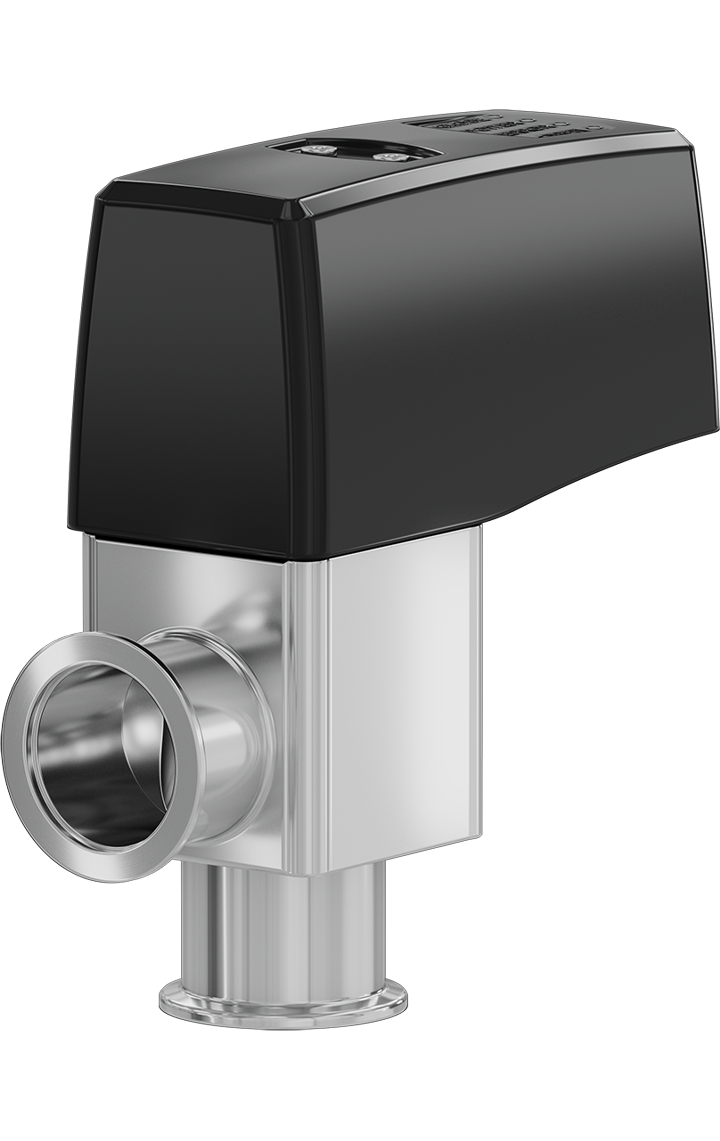In valves with pneumatic or electromagnetic actuators, shocks and vibrations inevitably occur when the valve gate is bumped or braked. Although such disturbances can be reliably reduced by a wide variety of technical tricks, in many applications the effort required for vibration damping is considerable or, in extreme cases, leads to restrictions in performance parameters.
For this reason, VAT is increasingly turning to electric drives. This type of drive is characterized by a precisely controllable closing or opening movement of the valve gate even with very short closing times. The increasing requirements in modern high-tech applications - such as the production of semiconductor chips - in terms of low vibration make this technical solution increasingly interesting for isolation valves as well.
Accordingly, in addition to the development of electric actuators for vacuum control valves, VAT has also been working on the development of motor-driven valve variants for vacuum isolation valves for several years. Special attention is being paid to the group of angle valves - a universal and very modular valve design that is used in an enormous number of applications. In angle valves, the electric actuator brings significant advantages in terms of shock and vibration prevention. Electrically driven angle valves do not require any additional mechanical vibration damping and can therefore be brought closer to vibration-critical process areas, which reduces the complexity of vacuum systems in many areas.
Individual Motor Layout for Every Application
In order to make the best possible use of the advantages of the electric actuator, individual power transmissions and motor layouts are defined for each valve application. For example, valves designed for ultra-fast cycle times must be operated with different motors than valves with normal closing cycles, and large valves with heavy gates require different motor dimensions than small valves.
It is common practice for VAT customers to subject the newly developed valves to their own testing and stake out possible areas of application. For the new, electrically driven angle valve variant 26.4, this "qualification phase" is currently in full swing: various companies in the research and industrial sectors are testing valves of this series and sounding out what possibilities the new performance parameters bring for the optimization of existing or the construction of future systems.
One such field test at India's renowned BARC large-scale research facility has now confirmed that the noise level of VAT's newly developed 26.4 (DN 25) series motor-controlled high-vacuum angle valve has been reduced to less than 48 dB, a clear parameter for shock and vibration avoidance. VAT's stated under 300 ms closing time also proved reliable in various load tests. With the announcement that the new angle valves are not only more smoothly controllable, but also very quick to close, VAT has not promised too much!

Major BARC facilities include a Pelletron Superconductor Linear Accelerator (TIFR), a Neutron Beam Research Facility, a series of state-of-the-art beamlines at the INDUS synchrotron, a TeV Atmospheric-Cherenkov Telescope in Ladakh, a folded-tandem ion accelerator, the PURNIMA fast neutron facilities directly on the BARC site, and a 10 MeV electron accelerator in cooperation with the Electron Beam Center in Mumbai. For all these complex research facilities, BARC is continuously developing innovative detectors, sensors, mass spectrometers, imaging techniques and vacuum system components in cooperation with suppliers such as VAT.
Trend Toward Lower-Vibration Vacuum Motion Components.
As for the isolation vacuum valves used at BARC and elsewhere, valves with a pneumatic opening or closing mechanism have been used successfully for many decades. But the increasing miniaturization of large-scale research and manufacturing facilities is forcing valve developers to rethink their approach. This is because pneumatic solutions are subject to shocks and vibrations when the valve discs are pushed or braked - and as demands increase, these disturbances have to be suppressed or taken into account in the system layout at ever-greater expense. The same applies to comparable electromagnetic solutions, in which the valve opening is controlled by means of a spring that is loaded and unloaded via a current-carrying solenoid cylinder coil.
Coarse movements are no longer an option in the high-precision production facilities of modern semiconductor manufacturers, for example. In view of the ever smaller structures that have to be precisely processed here, even minimal vibrations in the production systems have a noticeable impact on manufacturing quality. "Accordingly, we are observing an increasing demand on the market for vacuum isolation valves that have smoother movement behavior without restricting performance parameters, ideally with controllable movement profiles as with control valves," says Andreas Dostmann, VAT Customer Consultant Scientific Vacuum Applications, summarizing the initial situation.
Motion Control with Soft Action
Accordingly, VAT has been working for several years on the development of electrically driven vacuum isolation valves. The electric drive allows a movement profile of the valve plate with variable speeds to be generated quite flexibly, so that vibrations or shocks only occur to an extremely small extent. Of course, the VAT developers are always faced with the challenge of not trading the "softer" movement properties of the electric drive for slower closing or opening times, but rather of combining both properties in one solution!
With great success, as Andreas Dostmann notes with satisfaction: "All the new motorized isolation valve variants are characterized by the fact that the valves can be controlled extremely precisely without the closing times suffering. And we can thus largely avoid vibration effects that occur with the pneumatic solution!" For example, the end of the closing process can be gently cushioned in much the same way as in a passenger elevator, so that no jerky movements occur. In this way, the entire system is reliably prevented from vibrating due to the valve movement.
Electrically Closed Valves without Current
One key to this is the enormously fine degree of control offered by modern precision electric drives, with acceleration/deceleration changes in the millisecond range. However, the drive alone is not enough, of course, Andreas Dostmann reports: "To get the inertial and centrifugal forces under control as well as possible, we use a wide variety of technical innovations both on the drive side and on the side of the parts to be moved in the valve."
Since the motion cycles and the masses to be moved vary greatly from one series to the next, the VAT developers have to consider anew for each individual valve which power transmission and which motor layout best accentuate the advantages of the electric drive. They carefully weigh up which motor specifications are needed for valves with faster or slower cycle times, with longer or shorter stroke lengths, and with heavier or lighter discs. Any customer requirements in terms of reduced build volume also influence the actuator design.
Now also Electrically Driven Angle Valves
One of the series for which this challenge was recently mastered to the full satisfaction of the VAT developers is the high vacuum angle valves of the 26.4 series: Here, VAT now also has an electrified valve variant in its portfolio. As with the electromagnetic variant, in which the spring closes the valve as long as no current flows through the coil, the newly developed motor-operated high-vacuum angle valve is a so-called normally closed valve, i.e. it is reliably protected against power failures by closing the valve automatically when no more current flows through the motor.
Angle valves are typically used as secondary vacuum valves in research and in many industrial applications and have a correspondingly wide range of uses. Andreas Dostmann names a typical application example: "Large-scale research facilities such as particle accelerators are often so large that the sector valves used in the accelerator to isolate individual sections cannot simply be opened under the full load of atmospheric pressure. Accordingly, the vacuum sections must be ventilated beforehand, and this is precisely what such VAT high-vacuum angle valves are ideally suited for.
Also in so-called soft-pump controls, where the pressure in a vacuum chamber is successively reduced, angle valves of this type are used - sometimes also in cascades." VAT also offers some such cascades already combined within a single valve solution, e.g. the 29.2 series high-vacuum angle valve, in which a large angle valve is combined with a smaller angle valve as a bypass, thus achieving very gentle opening without pressure surge pulses.
Wide Range of Applications
Modern laser systems, such as those that appear in the BARC nuclear fuel cycle, are also promising areas of application for the new electrically driven angle valves. Andreas Dostmann comments: "Lasers are extremely sensitive to vibrations. The shocks caused by normal pneumatic valves are unacceptable there. Here, the motorized actuator can fully demonstrate its motion-smooth strengths, with similar fast closing times as the electromagnetic variant."
Tested and Found to be Good
Of course, all parameters that VAT presents to its customers for a new valve variant are carefully tested several times under defined standard conditions. But for many customers it is important to verify the parameters in their individual application context. Andreas Dostmann explains: "Most of our major customers have their own departments that test potential new components for their application quality. If the component passes the test, it can usually be procured and used by different departments of the customer." Appropriate verification for the motorized angle valves has now been carried out by physicists from the Department of Electromagnetic Applications and Instrumentation at BARC in India.
In a large research facility such as BARC, high-vacuum angle valves are needed in many places, and the testers were correspondingly curious about the extent to which the electrically driven valve variant could make their systems even more efficient in the future. During the two-month test phase, the test results very accurately confirmed the data predicted by VAT. The testers were also able to identify numerous BARC plants in which these low-vibration and fast-closing 26.4 HV angle valves could find future use.
